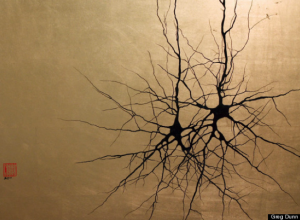Complex Architecture of our Neurons
G reg Dunn is a neuroscience PhD student at the University of Pennsylvania and an artist passionate about Japanese minimalist scrolls. While these interests may appear radically incongruous, Dunn’s artwork suggests otherwise. The artist creates dazzling works of enamel, gold leaf and ink inspired by science.
reg Dunn is a neuroscience PhD student at the University of Pennsylvania and an artist passionate about Japanese minimalist scrolls. While these interests may appear radically incongruous, Dunn’s artwork suggests otherwise. The artist creates dazzling works of enamel, gold leaf and ink inspired by science.
HP: Do you think the resemblance between neurons and brushstrokes are aesthetic or in their nature there is a similar essence to them?
Greg: Both, really. The reason that painting neurons works in the cannon of Asian aesthetics is that it is fundamentally the same process. It is the same natural forces which are creating something that the painters for thousands of years have observed and appreciated in things observable by the naked eye. Now with the microscope we have only recently been able to see that this beauty extends to the molecular level. It extends way, way way down to these levels of magnitude that we can’t really see.
And then there are the occasional stumpers that are impossible to decipher as neuron or nature. “Two Pyramidals,” for example, look like upside down dandelions far more than, as Dunn explained over the phone, “a type of neuron found in the brain that integrate information received from their dendrites, process it, and transmit it to other cells through its axon.”











